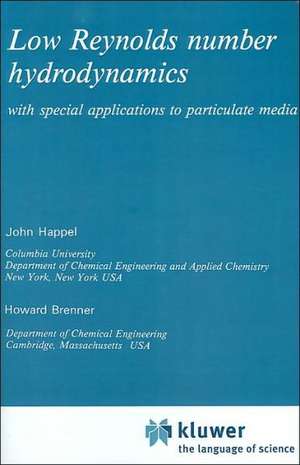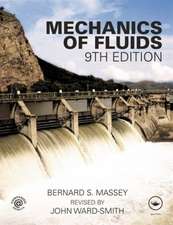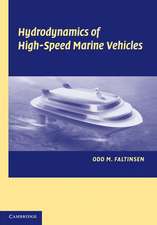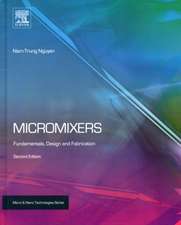Low Reynolds number hydrodynamics: with special applications to particulate media: Mechanics of Fluids and Transport Processes, cartea 1
Autor J. Happel, H. Brenneren Limba Engleză Paperback – 30 sep 1983
Preț: 995.30 lei
Preț vechi: 1213.77 lei
-18% Nou
Puncte Express: 1493
Preț estimativ în valută:
190.54€ • 195.96$ • 158.07£
190.54€ • 195.96$ • 158.07£
Carte tipărită la comandă
Livrare economică 17 februarie-03 martie
Preluare comenzi: 021 569.72.76
Specificații
ISBN-13: 9789024728770
ISBN-10: 9024728770
Pagini: 568
Ilustrații: XII, 553 p.
Dimensiuni: 160 x 240 x 30 mm
Greutate: 0.8 kg
Ediția:1983
Editura: SPRINGER NETHERLANDS
Colecția Springer
Seria Mechanics of Fluids and Transport Processes
Locul publicării:Dordrecht, Netherlands
ISBN-10: 9024728770
Pagini: 568
Ilustrații: XII, 553 p.
Dimensiuni: 160 x 240 x 30 mm
Greutate: 0.8 kg
Ediția:1983
Editura: SPRINGER NETHERLANDS
Colecția Springer
Seria Mechanics of Fluids and Transport Processes
Locul publicării:Dordrecht, Netherlands
Public țintă
ResearchCuprins
1. Introduction.- 1–1 Definition and purpose, 1. 1–2 Historical review, 8. 1–3 Application in science and technology, 13..- 2. The Behavior of Fluids in Slow Motion.- 2–1 The equations of change for a viscous fluid, 23. 2–2 Mechanical energy dissipation in a viscous fluid, 29. 2–3 Force and couple acting on a body moving in a viscous fluid, 30. 2–4 Exact solutions of the equations of motion for a viscous fluid, 31. 2–5 Laminar flow in ducts, 33. 2–6 Simplifications of the Navier-Stokes equations, especially for slow motion, 40. 2–7 Paradoxes in the solution of the creeping motion equations, 47. 2–8 Molecular effects in fluid dynamics, 49. 2–9 Non-newtonian flow, 51. 2–10 Unsteady creeping flows, 52..- 3. Some General Solutions and Theorems Pertaining to the Creeping Motion Equations.- 3–1 Introduction, 58. 3–2 Spherical coordinates, 62. 3–3 Cylindrical coordinates, 71. 3–4 Integral representations, 79. 3–5 Generalized reciprocal theorem, 85. 3–6 Energy dissipation, 88..- 4. Axisymmetrical Flow.- 4–1 Introduction, 96. 4–2 Stream function, 96. 4–3 Relation between stream function and local velocity, 98. 4–4 Stream function in various coordinate systems, 99. 4–5 Intrinsic coordinates, 100. 4–6 Properties of the stream function, 102. 4–7 Dynamic equation satisfied by the stream function, 103. 4–8 Uniform flow, 106. 4–9 Point source or sink, 106. 4–10 Source and sink of equal strength, 107. 4–11 Finite line source, 108. 4–12 Point force, 110. 4–13 Boundary conditions satisfied by the stream function, 111. 4–14 Drag on a body, 113. 4–15 Pressure, 116. 4–16 Separable coordinate systems, 117. 4–17 Translation of a sphere, 119. 4–18 Flow past a sphere, 123. 4–19 Terminal settling velocity, 124. 4–20Slip at the surface of a sphere, 125. 4–21 Fluid sphere, 127. 4–22 Concentric spheres, 130. 4–23 General solution in spherical coordinates, 133. 4–24 Flow through a conical diffuser, 138. 4–25 Flow past an approximate sphere, 141. 4–26 Oblate spheroid, 145. 4–27 Circular disk, 149. 4–28 Flow in a venturi tube, 150. 4–29 Flow through a circular aperture, 153. 4–30 Prolate spheroid, 154. 4–31 Elongated rod, 156. 4–32 Axisymmetric flow past a spherical cap, 157..- 5. The Motion of a Rigid Particle of Arbitrary Shape in an Unbounded Fluid.- 5–1. Introduction, 159. 5–2 Translational motions, 163. 5–3 Rotational motions, 169. 5–4 Combined translation and rotation, 173. 5–5 Symmetrical particles, 183. 5–6 Nonskew bodies, 192. 5–7 Terminal settling velocity of an arbitrary particle, 197. 5–8 Average resistance to translation, 205. 5–9 The resistance of a slightly deformed sphere, 207. 5–10 The settling of spherically isotropic bodies, 219. 5–11 The settling of orthotopic bodies, 220..- 6. Interaction between Two or More Particles.- 6–1 Introduction, 235. 6–2 Two widely spaced spherically isotropic particles, 240: 6–3 Two spheres by the method of reflections and similar techniques, 249. 6–4 Exact solution for two spheres falling along their line of centers, 270. 6–5 Comparison of theories with experimental data for two spheres, 273. 6–6 More than two spheres, 276. 6–7 Two spheroids in a viscous liquid, 278. 6–8 Limitations of creeping motion equations, 281..- 7. Wall Effects on the Motion of a Single Particle.- 7–1 Introduction, 286. 7–2 The translation of a particle in proximity to container walls, 288. 7–3 Sphere moving in an axial direction in a circular cylindrical tube, 298. 7–4 Sphere moving relative toplane walls, 322. 7–5 Spheroid moving relative to cylindrical and plane walls, 331. 7–6 k-coefficients for typical boundaries, 340. 7–7 One- and two-dimensional problems, 341. 7–8 Solid of revolution rotating symmetrically in a bounded fluid, 346. 7–9 Unsteady motion of a sphere in the presence of a plane wall, 354..- 8. Flow Relative to Assemblages of Particles.- 8–1 Introduction, 358. 8–2 Dilute systems—no interaction effects, 360. 8–3 Dilute systems—first-order interaction effects, 371. 8–4 Concentrated systems, 387. 8–5 Systems with complex geometry, 400. 8–6 Particulate suspensions, 410. 8–7 Packed beds, 417. 8–8 Fluidization, 422..- 9. The Viscosity of Particulate Systems.- 9–1 Introduction, 431. 9–2 Dilute systems of spheres—no interaction effects, 438. 9–3 Dilute systems—first-order interaction effects, 443. 9–4 Concentrated systems, 448. 9–5 Nonspherical and nonrigid particles, 456. 9–6 Comparison with data, 462. 9–7 Non-newtonian behavior, 469..- Appendix A. Orthogonal Curvilinear Coordinate Systems.- A-l Curvilinear coordinates, 474. A-2 Orthogonal curvilinear coordinates, 477. A-3 Geometrical properties, 480. A-4 Differentiation of unit vectors, 481. A-5 Vector differential invariants, 483. A-6 Relations between cartesian and orthogonal curvilinear coordinates, 486. A-7 Dyadics in orthogonal curvilinear coordinates, 488. A-8 Cylindrical coordinate systems, 490. A-9 Circular cylindrical coordinates, 490. A-10 Conjugate cylindrical coordinate systems, 494. A-ll Elliptic cylinder coordinates, 495. A-12 Bipolar cylinder coordinates, 497. A-l3 Parabolic cylinder coordinates, 500. A-14 Coordinate systems of revolution, 501. A-l5 Spherical Coordinates, 504. A-l6 Conjugate coordinate systems of revolution, 508. A-17Prolate spheroidal coordinates, 509. A-18 Oblate spheroidal coordinates, 512. A-19 Bipolar coordinates, 516. A-20 Toroidal coordinates, 519. A-21 Paraboloidal Coordinates, 521..- Appendix B. Summary of Notation and Brief Review of Polyadic Algebra.- Name Index.






















